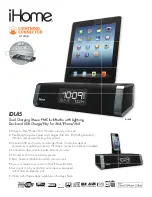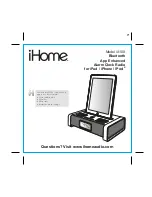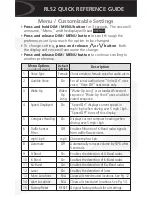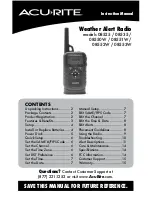
8
7.4 Favourites
You can save up to 30 of your favourite stations for quick
and direct access.
7.4.1 Saving favourites
•
Set the station that you would like to save as a favourite
station preset.
•
When the station is displayed, press and hold [memory]
on the front of the radio.
[
memory
]
After approx. 2 seconds, an overview window with the
favourites slots opens.
•
Turn [enter/navigate] to switch between the slots (1 to
30).
•
Press [enter/navigate] to store the station in the desired
favourites slot.
7.4.2 Opening favourites
Press [memory] to open the overview window with the list
of favourite stations.
[
memory
]
Use [enter/navigate] to select one of your favourites.
Note
Favourites cannot be deleted.
If all 10 station memory slots are filled and you wish to
save a new station, choose one of the occupied slots.
The station in this slot will be overwritten with the new
station.
7.4.3 Managing favourites with the remote control
Favourites 1-10
•
The included remote control has number keys
•
from 1 to 0 (0
≙
10). Each of these number keys can be
assigned with a favourite (for each reception mode).
•
To save a station, press and hold the corresponding
number key on the remote control (approx. three
seconds).
•
The radio confirms that the favourite has been saved with
the message „Preset stored” on the display.
•
To call the favourite again, briefly press the
corresponding number key on the remote control.
Favourites 1–30 (alternative to number buttons)
•
To store a station on favourites slots 1 to 30, press and
hold [FAVORITES] (approx. three seconds). After two
seconds, an overview window with the favourites slots
opens.
•
Use the favourites buttons [+] / [-] (turn [enter/navigate])
to switch between the slots (1 to 30).
•
Press [OK] ([enter/navigate]) to store the station in the
desired favourites slot.
•
To then open the favourites, briefly press [FAVORITES],
use the favourites buttons [+] / [-] (turn [enter/navigate])
to select the desired favourite and confirm your selection
by pressing [OK] ([enter/navigate]).
7.5 DRC (Dynamic Range Control)
Some DAB network radio stations support a volume control
feature that actively takes effect during playback. If the
volume suddenly increases, DRC automatically lowers it. If
the volume suddenly becomes quieter, DRC automatically
raises it. The same happens when playback is suddenly
quiet. The radio then increases the volume again.
DRC high:
total equalisation of different volumes. Strong
compression can audibly reduce the dynamics of a piece
of music.
DRC low:
partial equalisation of different volumes. More
subtle compression, without too much loss of dynamics.
DRC off:
no equalisation.






































